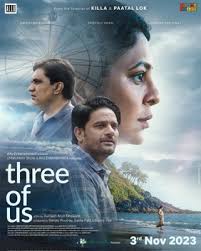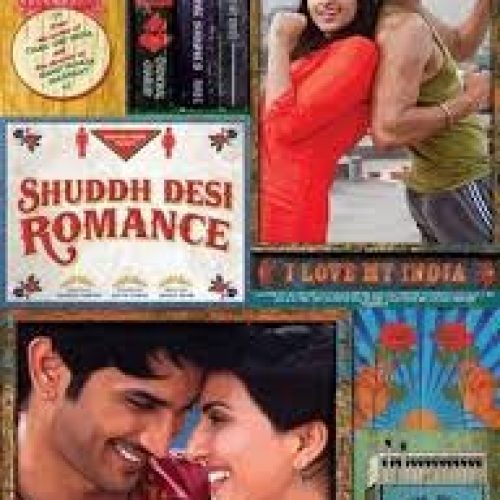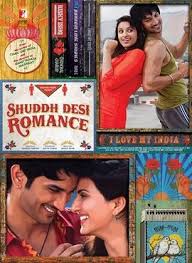Life can sometimes feel like an intimate dance between the past, present, and future, and Three of Us gracefully brings this dance to life. Starring Shefali Shah, Jaideep Ahlawat, and Swanand Kirkire, the film is set in a quaint, rural town somewhere in the heart of India, weaving a quiet yet complex narrative about love, memory, and the fragility of relationships. Directed by Avinash Arun, this 2022 drama leans into emotional depth, balancing intimacy with broader existential themes, making it a poignant piece of storytelling that draws viewers into its warm yet melancholic world.
The story revolves around a middle-aged couple, Shailaja (Shefali) and Pradeep (Jaideep), whose relationship is gradually deteriorating as they grapple with the emotional toll of Shailaja’s early-onset dementia. Together, they travel to a remote village, a place that holds personal significance for Shailaja, seeking peace and reconnection. They are joined by Pradeep’s old friend Ravi (Swanand), adding a layer of complexity to the situation. As they navigate the uncertainties of Shailaja’s condition, long-buried emotions and tensions rise to the surface, testing the bonds between the three of them. The film explores their individual struggles while subtly unravelling the connections they share, leading to a reflective journey on life, love, and the passing of time.
One of the standout elements of Three of Us is its performances, particularly from Shefali, who continues to prove her mastery over nuanced roles. As Shailaja, she brings a quiet dignity to a woman struggling with the loss of her memories and sense of self. The vulnerability she portrays is heart-wrenching yet never feels melodramatic. Her subtle facial expressions and moments of silence convey more than words could, making her performance incredibly powerful. Jaideep, as her conflicted husband, offers an equally layered portrayal. He captures the frustration and helplessness of a man trying to hold onto a relationship that’s slipping away, balancing tenderness with an underlying tension. Swanand, in the role of the friend caught in this delicate emotional web, provides much-needed levity while also revealing deeper layers of his character’s own unspoken sorrows. The trio’s chemistry feels organic, and each scene brims with unspoken emotions, making the acting one of the film’s strongest assets.
In terms of direction, Avinash Arun excels at using silence and stillness to evoke emotion. The film’s slow, deliberate pacing may not appeal to everyone, but it suits the story’s reflective tone. Arun’s direction emphasizes mood over plot, allowing the audience to sit with the characters’ emotions and thoughts. There’s a simplicity to the way scenes are framed—long, lingering shots of the natural landscape and close-ups that focus on the characters’ faces, allowing their expressions to convey the narrative. This minimalist approach enhances the film’s emotional weight without relying on overt drama. Arun also uses symbolism effectively, with the changing seasons and serene countryside reflecting the internal states of the characters, particularly Shailaja’s fading memories.
The cinematography by Amol Gole beautifully captures the rural setting, highlighting the peaceful yet isolated atmosphere of the village. Each frame feels painterly, with the lush greenery, flowing rivers, and open skies juxtaposed against the characters’ internal struggles. The natural beauty of the surroundings stands in contrast to the emotional turbulence within the characters, creating a poignant visual metaphor. Gole uses light and shadow effectively to convey mood, particularly in the evening scenes, where the fading daylight mirrors Shailaja’s slipping grasp on reality. The film’s quiet, almost meditative visual style contributes to the reflective tone, drawing viewers into the characters’ introspective journeys.
Musically, the film relies on a subtle background score that complements its understated narrative. There are no grandiose or overly dramatic musical cues; instead, the music flows gently, much like the river that often appears in the background. The score never overwhelms but rather enhances the emotional undercurrents of key scenes, particularly in moments of silence where the characters are lost in thought. The decision to keep the music minimal allows the natural sounds of the setting—birds chirping, leaves rustling, water flowing—to become part of the film’s auditory experience, further grounding the audience in the story’s rural landscape.
Another important aspect of the film is its exploration of time and memory. Shailaja’s dementia serves as a metaphor for the fragility of human connections and the inevitability of change. The film reflects on how we hold onto memories, both as individuals and within relationships, and how the loss of these memories can affect our sense of identity and belonging. The narrative is deeply introspective, inviting viewers to reflect on their own relationships and the passage of time. The theme of reconciliation runs throughout the film, not just between the characters but also within themselves, as they come to terms with their pasts and uncertain futures. The slow pacing allows these themes to unfold gradually, giving them room to breathe and resonate.
The film does have its challenges, particularly for viewers who prefer fast-paced narratives or clear resolutions. The deliberate pacing, while essential to the film’s tone, can feel drawn out at times, and the lack of a traditional plot structure may leave some audiences wanting more action or closure. However, this is also what makes the film special—it doesn’t rush its emotional beats, and it doesn’t force its characters into neat, tidy arcs. It leaves space for ambiguity, allowing the audience to sit with the characters’ emotions and draw their own conclusions about the nature of their relationships.
In conclusion, Three of Us is a beautifully crafted, introspective drama that relies on subtle storytelling and powerful performances to explore themes of memory, time, and human connection. Shefali’s nuanced portrayal of a woman battling dementia is a standout, supported by equally strong performances from Jaideep and Swanand. The film’s meditative pacing, evocative cinematography, and understated music create a reflective mood that draws viewers into the characters’ emotional worlds. While its slow pace and minimalistic approach may not appeal to everyone, those who appreciate quiet, character-driven stories will find Three of Us to be a deeply moving experience. For viewers seeking a thoughtful, emotionally resonant film about the complexities of relationships and the passage of time, this one comes highly recommended.







